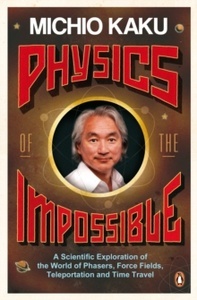Physics of the Impossible

Editorial Penguin UK
Fecha de edición abril 2009
Idioma inglés
EAN 9780141030906
352 páginas
Libro
encuadernado en tapa blanda
Resumen del libro
Physics of the Impossible takes us on a journey to the frontiers of science and beyond, giving us an exhilarating insight into what we can really hope to achieve in the future.
Everyday we see that what was once declared impossible' by scientists has become part of our everyday lives: fax machines, glass sky-scrapers, gas-powered automobiles, a worldwide communications network and high-speed elevated trains.
Here internationally bestselling author Micho Kaku confidently hurdles today's frontier of science, presenting the first truly authoritative exploration of the real science of tomorrow; a field normally left to writers of science fiction. He reveals the actual possibilities of perpetual motion, force fields, invisibility, ray guns, anti-gravity and anti-matter, teleportation, telepathy, psychokinesis, robots and cyborgs, faster than light travel, time travel, zero-point energy, extraterrestrial life, even clairvoyance. And he shows how few of these ideas actually violate the laws of physics. The real differences between the impossible, the unlikely and the imminent have never been so clear.
Biografía del autor
x{0026}lt;P x{0026}lt;B Michio Kaku,x{0026}lt;/B nacido en 1947 en California, Estados Unidos, de padres japoneses, es un eminente físico teórico y uno de los creadores de la teoría de campos de cuerdas. Apadrinado por Edward Teller, que le ofreció la beca de ingeniería Hertz, se formó en Harvard y en el Laboratorio Nacional Lawrence Berkeley de la Universidad de California, donde obtuvo el doctorado en física en 1972. Desde hace casi treinta años ocupa la Cátedra Henry Semat de Física Teórica en la Universidad de Nueva York y es uno de los divulgadores científicos más conocidos del mundo; presenta dos programas de radio y participa en espacios de televisión y documentales. Es autor además de decenas de artículos y de varios libros, algunos de ellos traducidos al castellano: x{0026}lt;I El universo de Einsteinx{0026}lt;/I (2005), x{0026}lt;I Universos paralelos x{0026}lt;/I (2008), x{0026}lt;I Física de loimposiblex{0026}lt;/I (2009), x{0026}lt;I El futuro de nuestra mentex{0026}lt;/I (2014), x{0026}lt;I La física del futuro x{0026}lt;/I (2011), x{0026}lt;I El futuro de la humanidadx{0026}lt;/I (2018) y x{0026}lt;I La ecuación de Diosx{0026}lt;/I (2022).x{0026}lt;/P








